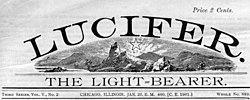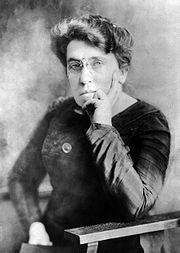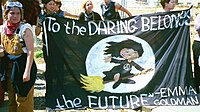Anarcha-feminism (also called anarchist feminism and anarcho-feminism) combines anarchism with feminism. It generally views patriarchy as a manifestation of involuntary hierarchy. Anarcha-feminists believe that the struggle against patriarchy is an essential part of class struggle, and the anarchist struggle against the State. In essence, the philosophy sees anarchist struggle as a necessary component of feminist struggle and vice-versa. As L. Susan Brown puts it, "as anarchism is a political philosophy that opposes all relationships of power, it is inherently feminist".[1]
Origins
Anarcha-feminism was inspired by late 19th and early 20th century authors and theorists such as anarchist feminists Emma Goldman, Voltairine de Cleyre and Lucy Parsons.[2] In the Spanish Civil War, an anarcha-feminist group, Mujeres Libres ("Free Women") linked to the Federación Anarquista Ibérica, organized to defend both anarchist and feminist ideas,[3] while Stirnerist Nietzschean feminist Federica Montseny held that the "emancipation of women would lead to a quicker realization of the social revolution" and that "the revolution against sexism would have to come from intellectual and militant 'future-women.' According to this Nietzschean concept of Federica Montseny's, women could realize through art and literature the need to revise their own roles."[4]The major male anarchist thinkers—with the exception of Proudhon—strongly supported gender equality. Bakunin, for example, opposed patriarchy and the way the law "subjects [women] to the absolute domination of the man." He argued that "[e]qual rights must belong to men and women" so that women can "become independent and be free to forge their own way of life." Bakunin foresaw the end of "the authoritarian juridical family" and "the full sexual freedom of women." [Bakunin on Anarchism, p. 396 and p. 397].[5] Proudhon, on the other hand, viewed the family as the most basic unit of society and of his morality and thought women had the responsibility of fulfilling a traditional role within the family.[6]
Since the 1860s, anarchism's radical critique of capitalism and the state has been combined with a critique of patriarchy. Anarcha-feminists thus start from the precept that modern society is dominated by men. Authoritarian traits and values—domination, exploitation, aggression, competition, etc.—are integral to hierarchical civilizations and are seen as "masculine." In contrast, non-authoritarian traits and values—cooperation, sharing, compassion, sensitivity—are regarded as "feminine," and devalued. Anarcha-feminists have thus espoused creation of a non-authoritarian, anarchist society. They refer to the creation of a society, based on cooperation, sharing, mutual aid, etc. as the "feminization of society."[5]
In Argentina Virginia Bolten is responsible for the publication of a newspaper called La Voz de la Mujer (English: The Woman's Voice), which was published nine times in Rosario between 8 January 1896 and 1 January 1897, and was revived, briefly, in 1901. A similar paper with the same name was reportedly published later in Montevideo, which suggests that Bolten may also have founded and edited it after her deportation.[7]
[edit] Anarcha-feminism, individualist anarchism and the free love movement
Main articles: Individualist anarchism and Free love
An important current within individualist anarchism is free love.[8] Free love advocates sometimes traced their roots back to Josiah Warren and to experimental communities, which viewed sexual freedom as a clear, direct expression of an individual's self-ownership. Free love particularly stressed women's rights since most sexual laws discriminated against women: for example, marriage laws and anti-birth control measures.[8] The most important American free love journal was Lucifer the Lightbearer (1883–1907) edited by Moses Harman and Lois Waisbrooker[9] but Ezra and Angela Heywood's The Word was also published from 1872–1890 and in 1892–1893.[8] Also M. E. Lazarus was an important American individualist anarchist who promoted free love.[8] In Europe the main propagandist of free love within individualist anarchism was Emile Armand[10] He proposed the concept of la camaraderie amoureuse to speak of free love as the possibility of voluntary sexual encounter between consenting adults. He was also a consistent proponent of polyamory.[10] In France there was also feminist activity inside French individualist anarchism as promoted by individualist feminists Marie Küge, Anna Mahé, Rirette Maitrejean, and Sophia Zaïkovska.[11]
Brazilian individualist anarchist Maria Lacerda de Moura lectured on topics such as education, women's rights, free love, and antimilitarism. Her writings and essays landed her attention not only in Brazil, but also in Argentina and Uruguay. In February 1923 she launched Renascença, a periodical linked with the anarchist, progressive, and freethinking circles of the period. Her thought was mainly influenced by individualist anarchists such as Han Ryner and Emile Armand.[12]
[edit] Emma Goldman
Main article: Emma Goldman
Although she was hostile to first-wave feminism and its suffragist goals, Emma Goldman advocated passionately for the rights of women, and is today heralded as a founder of anarcha-feminism, which challenges patriarchy as a hierarchy to be resisted alongside state power and class divisions.[13] In 1897 she wrote: "I demand the independence of woman, her right to support herself; to live for herself; to love whomever she pleases, or as many as she pleases. I demand freedom for both sexes, freedom of action, freedom in love and freedom in motherhood."[14]A nurse by training, Goldman was an early advocate for educating women concerning contraception. Like many contemporary feminists, she saw abortion as a tragic consequence of social conditions, and birth control as a positive alternative. Goldman was also an advocate of free love, and a strong critic of marriage. She saw early feminists as confined in their scope and bounded by social forces of Puritanism and capitalism. She wrote: "We are in need of unhampered growth out of old traditions and habits. The movement for women's emancipation has so far made but the first step in that direction."[15][16]
[edit] Mujeres Libres
Main article: Mujeres Libres
Mujeres Libres (English: Free Women) was an anarchist women's organization in Spain that aimed to empower working class women. It was founded in 1936 by Lucía Sánchez Saornil, Mercedes Comaposada and Amparo Poch y Gascón and had approximately 30,000 members. The organization was based on the idea of a "double struggle" for women's liberation and social revolution and argued that the two objectives were equally important and should be pursued in parallel.In order to gain mutual support, they created networks of women anarchists. Flying day-care centres were set up in efforts to involve more women in union activities.[17]
In revolutionary Spain of the 1930s, many anarchist women were angry with what they viewed as persistent sexism amongst anarchist men and their marginalized status within a movement that ostensibly sought to abolish domination and hierarchy. They saw women's problems as inseparable from the social problems of the day; while they shared their comrade's desire for social revolution they also pushed for recognition of women's abilities and organized in their communities to achieve that goal. Citing the anarchist assertion that the means of revolutionary struggle must model the desired organization of revolutionary society, they rejected mainstream Spanish anarchism's assertion that women's equality would follow automatically from the social revolution. To prepare women for leadership roles in the anarchist movement, they organized schools, women-only social groups and a women-only newspaper so that women could gain self-esteem and confidence in their abilities and network with one another to develop their political consciousness.
[edit] Themes
An important aspect of anarcha-feminism is its opposition to traditional conceptions of family, education and gender roles;[18] the institution of marriage is one of the most widely attacked.[19] De Cleyre argued that marriage stifled individual growth,[20] and Goldman argued that it "is primarily an economic arrangement... [woman] pays for it with her name, her privacy, her self-respect, her very life."[21] Anarcha-feminists have also argued for non-hierarchical family and educational structures, and had a prominent role in the creation of the Modern School in New York City, based on the ideas of Francesc Ferrer i Guàrdia.[22]
In English-speaking anarcha-feminist circles in the United States, the term "Manarchist" emerged as a pejorative label for male anarchists who are dismissive of feminist concerns, who are overtly antifeminist, or who behave in ways regarded as patriarchal and misogynistic.[citation needed] The term was used in the 2001 article "Stick it To The Manarchy"[23] and later in a 2001 questionnaire, "Are You a Manarchist?".[24]
There is some concern that Anarcha-feminists in the developed world can be dismissive of third world feminist concerns. This has been noted especially in the plight of Anarcha-feminists in the Middle East.[citation needed]
In modern times anarcha-feminism has been noted for its heavy influence on ecofeminism. "Ecofeminists rightly note that except for anarcha feminist, no feminist perspective has recognized the importance of healing the nature/culture division."[25]

Mujeres Creando's Mujer Publica, May 2004. Mujeres Creando's anarcha-feminism also emphasizes LGBT issues, all in the context of Bolivia.
Recently,[when?] Wendy McElroy has defined a position (she describes it as "ifeminism" or "individualist feminism") that combines feminism with anarcho-capitalism, arguing that a pro-capitalist, anti-state position implies equal rights and empowerment for women.[26] Individualist anarchist feminism has grown from the US-based individualist anarchism movement.
Contemporary anarcha-feminist writers/theorists include Germaine Greer, L. Susan Brown, the eco-feminist Starhawk and the post-left anarchist and anarcho-primitivist Lilith.[27] The vagabond lesbian feminist Valerie Solanas exposed anarcha-feminist views in her famous text SCUM Manifesto where she writes "Life in this society being, at best, an utter bore and no aspect of society being at all relevant to women, there remains to civic-minded, responsible, thrill-seeking females only to overthrow the government, eliminate the money system, institute complete automation and destroy the male sex."[28]
[edit] See also
- Ecofeminism
- Individualist feminism
- Peggy Kornegger
- Radical feminism
- The Firebrand (later Free Society), BlueStockings Journal, and Lucifer the Lightbearer, turn-of-the-century feminist anarchist publications
[edit] References
- Martha A. Ackelsberg, Free Women of Spain: Anarchism and the Struggle for the Emancipation of Women (AK Press: 2005)
- Susan Brown, "Beyond Feminism: Anarchism and Human Freedom", Anarchist Papers 3 (Black Rose Books: 1990)
- Roxanne Dunbar-Ortiz, editor, Quiet Rumours: An Anarcha-Feminist Reader (Dark Star: 2002)
- Margaret S. Marsh, Anarchist Women, 1870–1920 (1981)
[edit] Footnotes
- ^ Brown, p. 208.
- ^ Dunbar-Ortiz, p.9.
- ^ Ackelsberg.
- ^ Spencer Sunshine, "Nietzsche and the Anarchists"
- ^ a b An Anarchist FAQ. What is Anarcha-Feminism?
- ^ Broude, N. and M. Garrard (1992). The Expanding Discourse: Feminism And Art History. p. 303. Westview Press. ISBN 978-0064302074
- ^ Molyneux, Maxine (2001). Women's movements in international perspective: Latin America and beyond. Palgrave MacMillan. p. 24. ISBN 9780333786772. http://books.google.com/books?id=yg9HFrOG89kC&pg=PA24.

- ^ a b c d The Free Love Movement and Radical Individualism By Wendy McElroy
- ^ Joanne E. Passet, "Power through Print: Lois Waisbrooker and Grassroots Feminism," in: Women in Print: Essays on the Print Culture of American Women from the Nineteenth and Twentieth Centuries, James Philip Danky and Wayne A. Wiegand, eds., Madison, WI, University of Wisconsin Press, 2006; pp. 229-50.
- ^ a b E. Armand and "la camaraderie amoureuse." Revolutionary sexualism and the struggle against jealousy
- ^ "Individualisme anarchiste et féminisme à la « Belle Epoque »"
- ^ "Maria Lacerda de Moura - Uma Anarquista Individualista Brasileira" by
- ^ Marshall, p. 409.
- ^ Quoted in Wexler, Intimate, p. 94.
- ^ Goldman, Anarchism, p. 224.
- ^ See generally Haaland; Goldman, "The Traffic in Women"; Goldman, "On Love".
- ^ Mujeres Libres - Women anarchists in the Spanish Revolution
- ^ Emma Goldman, "Marriage and Love", in Alix Kates Shulman (ed.), Red Emma Speaks: An Emma Goldman Reader, Schocken Books, N.Y., 1982, pp. 204-13.
- ^ Goldman, "Marriage and Love".
- ^ Voltairine de Cleyre, They Who Marry Do Ill (1907)
- ^ Goldman, "Marriage and Love", Red Emma Speaks, p. 205
- ^ Paul Avrich, The Modern School Movement: Anarchism and Education in the United States.
- ^ [1]
- ^ Are You A Manarchist?
- ^ Tuana, Nacy. Tong, Rosemarie. 'Feminism and Philosophy' Westview Press (1995) p. 328
- ^ Wendy McElroy, XXX: A Woman's Right to Pornography.
- ^ Lilith texts at the anarchist library
- ^ The S.C.U.M. Manifesto by Valerie Solanas







No comments:
Post a Comment